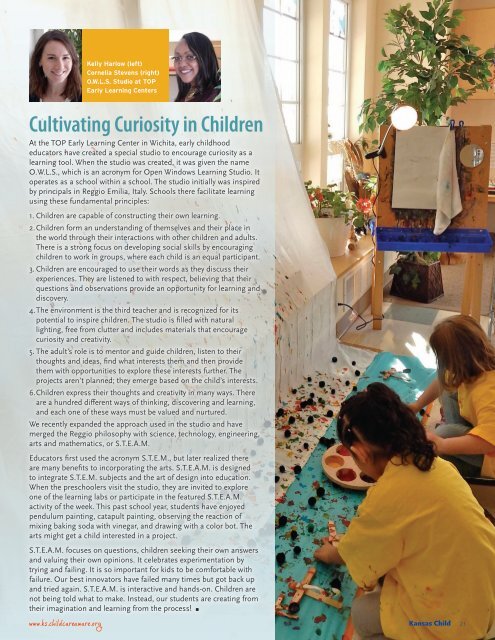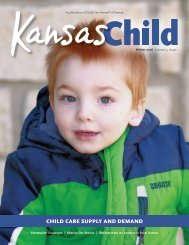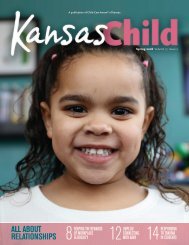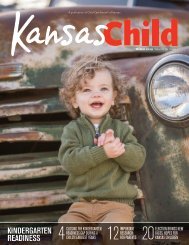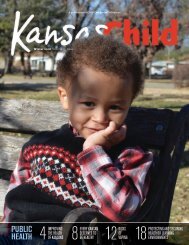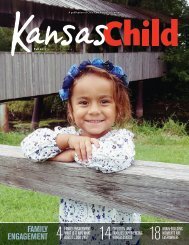2017 Summer Kansas Child
Create successful ePaper yourself
Turn your PDF publications into a flip-book with our unique Google optimized e-Paper software.
Kelly Harlow (left)<br />
Cornelia Stevens (right)<br />
O.W.L.S. Studio at TOP<br />
Early Learning Centers<br />
Cultivating Curiosity in <strong>Child</strong>ren<br />
At the TOP Early Learning Center in Wichita, early childhood<br />
educators have created a special studio to encourage curiosity as a<br />
learning tool. When the studio was created, it was given the name<br />
O.W.L.S., which is an acronym for Open Windows Learning Studio. It<br />
operates as a school within a school. The studio initially was inspired<br />
by principals in Reggio Emilia, Italy. Schools there facilitate learning<br />
using these fundamental principles:<br />
1. <strong>Child</strong>ren are capable of constructing their own learning.<br />
2. <strong>Child</strong>ren form an understanding of themselves and their place in<br />
the world through their interactions with other children and adults.<br />
There is a strong focus on developing social skills by encouraging<br />
children to work in groups, where each child is an equal participant.<br />
3. <strong>Child</strong>ren are encouraged to use their words as they discuss their<br />
experiences. They are listened to with respect, believing that their<br />
questions and observations provide an opportunity for learning and<br />
discovery.<br />
4. The environment is the third teacher and is recognized for its<br />
potential to inspire children. The studio is filled with natural<br />
lighting, free from clutter and includes materials that encourage<br />
curiosity and creativity.<br />
5. The adult’s role is to mentor and guide children, listen to their<br />
thoughts and ideas, find what interests them and then provide<br />
them with opportunities to explore these interests further. The<br />
projects aren’t planned; they emerge based on the child’s interests.<br />
6. <strong>Child</strong>ren express their thoughts and creativity in many ways. There<br />
are a hundred different ways of thinking, discovering and learning,<br />
and each one of these ways must be valued and nurtured.<br />
We recently expanded the approach used in the studio and have<br />
merged the Reggio philosophy with science, technology, engineering,<br />
arts and mathematics, or S.T.E.A.M.<br />
Educators first used the acronym S.T.E.M., but later realized there<br />
are many benefits to incorporating the arts. S.T.E.A.M. is designed<br />
to integrate S.T.E.M. subjects and the art of design into education.<br />
When the preschoolers visit the studio, they are invited to explore<br />
one of the learning labs or participate in the featured S.T.E.A.M.<br />
activity of the week. This past school year, students have enjoyed<br />
pendulum painting, catapult painting, observing the reaction of<br />
mixing baking soda with vinegar, and drawing with a color bot. The<br />
arts might get a child interested in a project.<br />
S.T.E.A.M. focuses on questions, children seeking their own answers<br />
and valuing their own opinions. It celebrates experimentation by<br />
trying and failing. It is so important for kids to be comfortable with<br />
failure. Our best innovators have failed many times but got back up<br />
and tried again. S.T.E.A.M. is interactive and hands-on. <strong>Child</strong>ren are<br />
not being told what to make. Instead, our students are creating from<br />
their imagination and learning from the process! n<br />
www.ks.childcareaware.org <strong>Kansas</strong> <strong>Child</strong> 21


